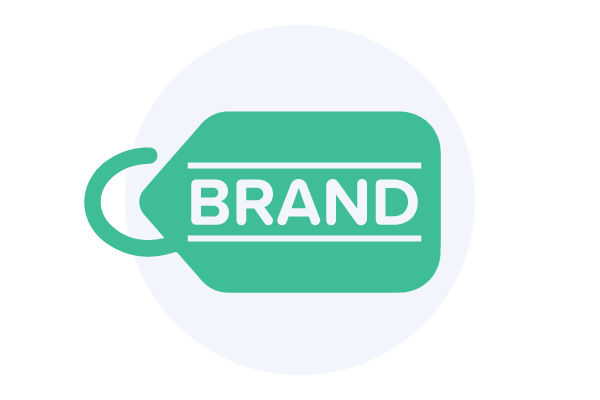Brands: The Definitive Guide (2019)
When Branding is done right, brands make a complex world simple.
However, nowadays, brands are often being used out of context, and so-called professionals have overcomplicated the meaning of brands.
This Guide avoids all the brand bullshit and covers everything you need to know about brands.
Let’s get started!

Contents
CHAPTER 1:
Brand Basics
First, let’s begin with the basics.
After all, Brands seem to be everywhere (and most of the noise is out of context).
So we start by defining what brands actually are.
What is a Brand?
A brand is, what consumers believe it is.
That’s it.
Pretty easy, right?
Not always! In general, there’s an enormous amount of confusion, as to what a brand is.
Especially among small businesses, this is true.
There are countless definitions of what a brand is.
Moreover, while all of them may be correct, most of them are not sufficient to explain the current behavior of consumers.
The best definition of a brand is probably the one from British advertising legend David Ogilvy.
Already back in 1951, he described a brand as: “the consumer’s idea of a product.“
This definition has proven to be accurate to this day.
A brand only exists in the minds of consumers. After all, they are the ones who buy a brand.
Any brand is only as good, as consumers believe it to be.
To put it in other words: A brand is a positive preconception.
What is a positive preconception?
The positive preconception about a brand is comprehensive knowledge about the brand, which influences the purchase decision significantly.
For example:
Try to match below brands with below beverages.
Brands:
- Starbucks
- Red Bull
- Coca Cola
Beverages:
- Cola
- Coffee
- Energy Drink
I guess you can immediately tell which beverage belongs to which brand.
When you think of these brands, it’s very likely that you have specific experience in mind, that you connect with each of these brands.
That’s because all of these brands have accomplished to form a positive preconception about their brand in the general public.
Most of the time, people refer to preconceptions (another word for prejudice or bias) in a negative context.
However, for brands AND consumers, they only have advantages.
In fact: Without preconceptions, everyday life would be impossible.
They reduce complexity so that you immediately know very precisely what you can expect when buying the brand, without further explanation.
How is a positive preconception formed?
Consumers form a positive preconception through positive experiences.
When consumers become aware of your brand for the first time, they have no associations with your brand at all.
They don’t know anything about it.
Consumers then experience your brand for the first time.
For example: They could see your advertisement for the first time. Or they might spot your brand in a store and try it out.
After they’ve had their first experience with your brand, consumers evaluate: Either they like the experience, or they don’t like it.
So they either react with approval or rejection.
If they like the experience, consumers most likely will want to repeat the experience.
Also, if their experience is just as good as the first one, they will like it again.
This is important, as the positive preconception needs confirmation with every purchase.
Even when a brand is changing, customers must always have a consistent experience.
The customers’ preconception of the brand needs to be confirmed again and again.
Consistent experiences build a brand.
As soon as consumers have had several good experiences, a brand begins to have an effect.
Positive experiences lead to positive evaluations from which consumers form a positive preconception.
Why does the positive preconception matter?
A positive preconception is the best way to beat the competition.
Today’s competition is about customers having the most beneficial preconception of your brand.
The stronger the positive preconception of a brand, the more attractive it is for customers.
The positive preconception gives a brand its power. It’s the best way to beat the competition.
It needs to be better than the customers’ preconception of your competitors.
The positive preconception is, therefore, your most important goal to make your brand stick in the mind of your customers.
Today’s competition is a war for the most influential positive preconception.
This battle runs through all industries, regardless of the price segment or quality league in which your brand operates.
If you focus on your consumers having the same positive experiences over and over again, you will make your brand stick in the minds of your customers.
Consumers with a positive preconception will love about anything your brand does.
Also, they will keep on loving your brand, as long as you keep it consistent.
CHAPTER 2:
The History of Brands
In times of constant change and heightened customer expectations, brands are incredibly relevant.
And it’s not only our Fast-Paced World where brands are so important.
Let’s see how brands evolved.

How is a brand created?
A brand always begins with an idea.
The founder of a brand has an idea and wants to bring that idea to the market.
For example, the idea could be
- a new product that this person wants to add to other people’s lives or
- a gap in the market, which the founder would like to close.
There are limitless possibilities.
Markets today are very differentiated, which is why true pioneers with a completely new idea are rare.
Details can make a difference.
As soon as the founder has evaluated his idea, he tries to scale it.
The finished product then encounters consumers.
Consumers get a picture of the product and evaluate it.
Ideally, consumers react with affection and later with approval.
At best, enough people are willing to spend their hard-earned money on the product.
The idea of a founder has created a new brand.
Since when do brands exist?
Brands are not an invention of our time.
They exist since people started trading.
The first brands can be traced back to over 2000 years before Christ.
Already back then some Egyptians believed, that their bricks were better than the once of their competitors. To point out superior quality, they put a symbol on their bricks.
Archaeologists also found marks (brands) on the walls of Troy or buildings in Rome or Jerusalem.
The blacksmith would engrave his swords to distinguish himself from his competitors.
The potter designed his vases according to a unique pattern for customer retention.
Even back then, brands were a frequent topic of conversation.
CHAPTER 3:
Benefits for Businesses
There are four main reasons why businesses need brands.
Of course, making money is involved.
But it’s only one of the four reasons.

1) Differentiation
In today’s competitive environment, most businesses keep a close watch on their biggest competitors.
They track every step and relate to their biggest rivals for new ideas.
As a result, many brands are becoming interchangeable. They become more and more similar to each other.
But: Interchangeability is any brand’s biggest enemy.
So avoiding interchangeability opens up a great opportunity for you!
If your brand were like any other brand, customers would have no reason to choose your brand over any other brand.
Brands thrive on differentiation.
Being different makes the difference.
Once you are able to establish meaningful differentiation, customers will choose your brand over any other brand.
Actually, they won’t even think of buying another brand.
Moreover: as a bonus, your customer base won’t focus so much on price.
They will be willing to pay extra so that they can get your brand instead of another brand.
So a strong brand really pays off.
You will be rewarded with an extremely loyal customer base.
2) Brand Recognition
More on what Brand Recognition is later in the Chapter of Branding Terms.
Truly successful brands take it one step further.
They are not only recognized by their Branding but mainly by experiences.
In fact: Brand recognition is built by experiences.
Customers have certain experiences with a brand.
They enjoy these experiences and repeat them.
As they repeat them, these experiences become typical for a brand.
Customers are able to recall your brand, which makes a purchase more likely.
Therefore, brand recognition strongly supports Customer Retention.
3) Halo-Effect
Usually, you need to try a product first, before you know, if you like it.
For brands, there’s also the Halo-Effect.
The Halo-Effect is a cognitive bias.
It describes an effect when customers like a product which they’ve never tried, based on their positive experiences with other products of that brand.
It’s like a head-start.
Once customers like one product of a brand, they become irrational and seem to like everything about that brand.
Even the products and features, which they don’t know.
Based on their positive experiences of other products of that brand, they would like a product which they’ve never tried.
The reasoning of customers is that if a brand is exceptionally good at one thing, they will undoubtedly be good at anything else.
To create the Halo-Effect, your brand needs to capitalize on its strengths.
It would be best if you made sure that customers have positive experiences with the products of your brand.
Customers then will cognitively form a bias in favor of your brand and your offerings despite having no positive experience with those offerings.
Brands like apple benefit significantly from the halo-effect: A loyal fan base anticipates every product launch. Every new product, like a smartwatch, must be good, because it’s made by Apple, right?!
You can use the Halo-Effect to establish yourself as a leader in your industry.
Once Customers have had positive experiences with your brand, the Halo-Effect begins to make an impact.
These customers have very positive thoughts about your brand.
For the features they don’t know about your brand, they expect them to be good.
These customers would even recommend your brand to their friends and family
In case your brand becomes topic of conversation (which it will, as brands are one of the most common topics of discussion) they would even promote your brand or defend it if someone speaks in a wrong way about your brand.
So, the Halo-Effect results in an extremely loyal customer base, that would never buy from any other brand.
4) Brand Equity
Having a strong brand is not only a nice feature of a business.
It’s also a substantial financial asset.
For example: In 2018, just the Apple brand (without anything physical to it) is worth 214 Billion USD!
Having a strong brand is not only nice to have. It also pays off.
The more your brand influences consumers to buy your brand and convert them to repeat customers, the more it increases the brand value.
So what really makes a strong brand is the degree to which it satisfies customers.
Therefore, having a valuable brand is not only a significant financial asset.
Customers also:
- feel a higher desire to buy a brand.
- become more loyal.
CHAPTER 4:
Benefits for Customers
Okay, that businesses need brands was kind of obvious.
But what about consumers?
There are seven main reasons why customers need brands even more than businesses do.

Why do consumers need brands?
Customers need brands because they make their lives easier.
As a matter of fact, customers need brands even more than businesses do.
There are seven functions of how brands create value for customers:
- Identification
- Practicality
- Guarantee
- Optimization
- Badge
- Continuity
- Ethical
These functions should not be seen as laws.
While the functions should be applicable to most brands, some functions may not apply to any brand.
It depends on the individual product category.
1) Identification
Image a world without brands: A scenario, in which brands wouldn’t exist.
You would have no choices when it came to what
- shoes to wear,
- car to drive,
- coffee to drink or
- newspaper to read
Everything would be the same.
A terrible scenario.
Fortunately, it is a scenario that is only real in the former Soviet Union and today’s North Korea.
2) Practicality
Imagine a scenario in which Brands do exist, but they would all look the same.
You’d be at the grocery store trying to buy beer.
There are many different brands. But none of them has a label on it.
They all look the same. It would take forever to pick your desired brand.
Therefore, brands make picking the desired product easy.
With minimum thought, consumers can differentiate between the different brands.
This enables consumers to save time and energy.
Only because of brands, we can make decisions in everyday life efficiently.
3) Guarantee
Whenever you buy a brand which you’ve never bought before, you don’t know if you will like it.
You may have a good feeling about the product (for example because of an ad).
Or a friend recommended this product to you (and told you about his experience).
Either way: You don’t know if you will like the brand for sure.
You only know if you like a brand after you’ve tried it for yourself.
From this point on, a brand begins to make an impact:
Any time you buy the brand, you can be sure to receive the same quality as for your first purchase.
No matter when you buy the brand. No matter where you buy it.
It’s always the same.
Therefore the function of guarantee provides safety, as it reduces the perceived risk significantly.
4) Optimization
Think of the fashion industry.
There are so many brands that consumers can choose from.
While many consumers have favorite brands, none of the brands is the best brand with absolute certainty.
Every consumer has different reasons why a specific brand is the best choice for him.
Consumers pick the brand that suits them best.
They can be sure to buy the best product in a category, based on their personal preferences.
5) Badge
Brands also express who we are: We make a statement about us by
- the shoes we wear,
- the smartphone we own or
- the car we drive.
Brands show who we are and whom we want to be.
They are a way of presenting ourselves to others to confirm our self-image.
6) Continuity
Many businesses aim to increase Customer Loyalty.
However, customer loyalty is something that customers aim for as well.
Customers feel satisfaction from the relationship with a brand.
They even become attached to brands that they like.
There is no reason to buy a different brand if you are satisfied with the one you buy.
Customers want to be loyal to a brand.
So it would be best if you gave them a great reason to be loyal to your brand.
7) Ethical
More and more brands also show responsible behavior.
That makes customers feel good by buying a brand because this brand does well to others.
Consumers are no longer just interested in quality and value for money.
They want to have a good conscience when they consume a product or use a service.
For example, the demand for organic food has been growing for years, although the prices there are still higher than those of conventional food.
CHAPTER 5:
Branding Terms
There is a long list of terminology built around a brand.
Some brand terms are important to know.
Others not so much.
That’s why it helps to know the most relevant branding terms.

What is Brand Management?
Brand Management is the process of developing, improving, and protecting your brand so that consumers develop a positive preconception about your brand.
It uses methods and techniques to increase the perceived value of your brand over time, leading to satisfied customers (and therefore higher sales).
By differentiating your offering from those of your competitors, your brand benefits from a unique shape.
Brand Management also defines a scope of action for everyone else in the business (to keep consumer experience consistent).
It is also very closely related to managing a business and is usually done by the leader of a company.
What is a Brand Identity?
Brand Identity is a significant concept in Brand Management.
It defines the essential characteristics of a brand from an internal point of view.
All messages that your brand wants to send in terms of product, price, place, or promotion should be consistent with your brand identity.
These messages include (but are not limited to) the purpose, values, differentiation, and design of a brand.
Once you know what your brand stands for, you can affect the way you want consumers to think about your brand, whenever they interact with it.
What is a Brand Image?
Based on specific experiences with a brand, consumers develop a particular Brand Image.
Your Brand Image is what your customers believe your brand to be.
The goal should always be, to have a Brand Image that is beneficial to consumers’ willingness to buy your brand.
Only a consistent brand image ensures that consumers perceive your brand as you want them to.
What is a Brand Positioning?
Brand Positioning forms the bridge between your Brand Identity and your consumers Brand Image.
It’s the strategy, with which you try to trigger such strong preferences among consumers so that they only know, use, and buy your brand.
Therefore, every positioning strategy must distinguish your brand from relevant competitors.
A brand positioning also directly influences consumers’ preferences, so it also affects consumer loyalty, consumer-based brand equity, and consumers’ willingness to purchase your brand.
What is Brand Trust?
Brand Trust refers to how strongly consumers trust your brand.
The more consumers trust your brand, the more likely they will buy it.
So increasing trust is a very efficient way of increasing sales.
However, building trust isn’t done quickly: To build deep trust, your brand needs to deliver a utility in a consistent manner and quality over a long time.
The concept of trust thus consists of two elements: Trust = Consistent utility + time
According to a study by Nielsen, 83% of consumers trust say they completely or somewhat trust the recommendations of friends and family.
That means focusing on satisfied customers that voluntarily recommend your brand to their family and friends is the most efficient way to build trust.
Trust is the most efficient way of doing business successfully, as having trust in a brand simplifies, improves, or even enables consumers’ everyday life in the first place.
What is Brand Awareness?
Brand Awareness describes the degree, to which consumers can recognize your brand by its name.
It’s actually one of the most common small business problems.
High Brand Awareness means that your brand is well known.
That’s important because consumers cannot buy what they don’t know.
Brand Awareness has a positive impact on marketing efforts, consumer perception, and revenue.
It consists of two components: Brand Recognition and Brand Recall.
What is Brand Recognition?
Brand Recognition describes the degree, to which consumers are able to recognize your brand without seeing its brand name.
It’s how much they can recognize your brand by its features of Brand Design:
- logo
- tagline
- shapes
- graphics
- colors
- smells
- taste
- sounds
For example: Can you think of a clothing company that is recognized by a checkmark or a gas station that has the symbol of a shell?
What is Brand Recall?
Brand Recognition describes the degree, of how well consumers connect your brand name with a specific product type or class of products.
It is often tested through surveys or interviews, by asking participants questions such as:
“Name as many shoe brands as you can think of.”
If many participants name your brand, your brand is closely linked to the product category.
